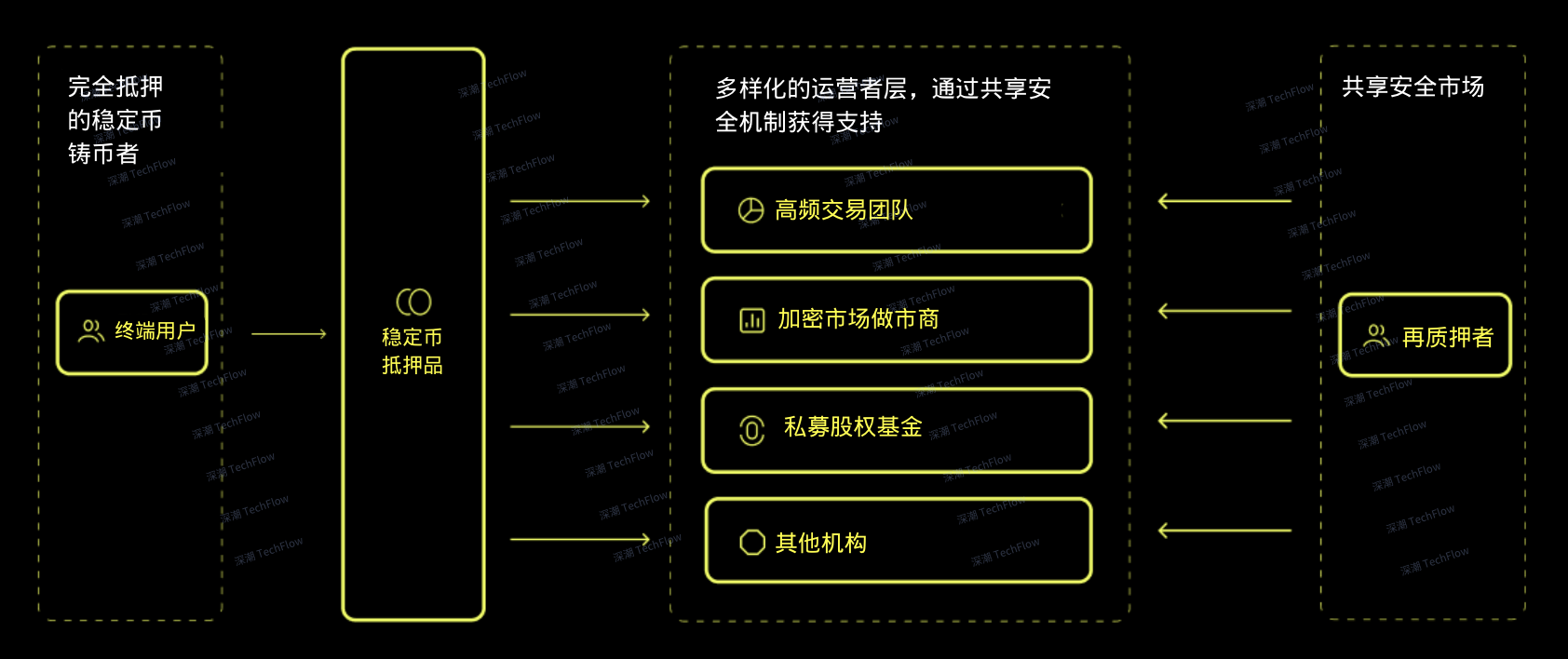Each participant in CAP (coiners, operators, and re-pledgers) unlocked new revenue opportunities by contributing value.
Author:DeFi Dave
Compiled by: Shenchao TechFlow

The rise of the online platform economy has helped many small start-ups grow into today’s technology giants, and it’s all based on a seemingly counterintuitive phenomenon:They do not own any assets needed for their core business。The most classic example is that Uber does not own any vehicles in the fleet, and Airbnb does not own any rooms on the platform. These companies use the power of the market to accurately match service demanders and providers, whether it is short-distance travel or temporary accommodation in urban areas. Compared with traditional enterprises that need to handle complex logistics matters such as vehicle maintenance and license approval, these platforms can focus on optimizing technology, improving user experience, and improving efficiency, thereby achieving unlimited business expansion.
Similar dynamics exist in the world on the chain.On the one hand, users seeking revenue, and on the other hand, agreements and participants providing revenue, which are promoted through various strategies.annualized rate of return (APY)。However, whether gains are obtained through market strategies such as leverage in mortgage bonds (CDP), interest on government bonds (T-Bills), or basis trading, a single strategy will encounter bottlenecks when achieving large-scale delivery.
The story of two (limited) designs
Traditional projects often rely on endogenous design, and their benefits come from the use needs of the platform. For example, the lending market and perpetual contracts rely on users ‘willingness to leverage, while the token flywheel effect requires new investors to continue to purchase governance tokens. However, if the platform lacks demand (whether it is leverage demand or token purchase demand), the liquidity supply will not be able to reap benefits. This design is similar to Ouroboros and cannot surpass itself to achieve sustainable development.
For newer exogenous strategies, protocols often ask the wrong question: Which strategy can achieve the greatest scale? In fact,No strategy can scale infinitely.When alpha dries up, all strategies eventually become obsolete and developers have to go back to the design stage.
So, what issues should stablecoins pay attention to? As the core hub of capital formation, stablecoins need to think.How to efficiently allocate capital and how to ensure the safety of users ‘funds.To achieve true success, the blockchain ecosystem requires a flexible and secure stablecoin solution.
CAP admission
CAP is the first stablecoin agreement to outsource revenue generation in a programmatic manner and provide comprehensive protection.
Who constitutes CAP?
The core of the CAP system consists of three types of participants:Coiners, operators and re-agentspledgepeople.
-
Minters: The minter is a stablecoin user who holds cUSD. cUSD can always be exchanged for USDC or USDT as its underlying mortgage asset at a 1:1 ratio.
-
Operators: Operators are institutions capable of implementing large-scale revenue-generation strategies, including banks, high-frequency trading (HFT) companies, private equity firms, real-world asset agreements (RWA agreements), decentralized financial agreements (DeFi agreements), and liquidity funds.
-
againpledgeRestakers: A re-pledger is a pool of funds that locks in capital. It protects stablecoin users by providing security for the operator’s activities, and thus obtains the right to use their re-pledged ETH.

(Original picture comes from DeFi Dave, compiled by Shenzhen TechFlow)
How CAP works
CAP’s smart contracts clearly define operating rules for all participants, including fixed requirements, penalty mechanisms and reward mechanisms.
-
stablecoin users deposit USDC or USDT and cast cUSD at a 1:1 ratio. Users can choose to mortgage cUSD to earn income, or directly use it as a stablecoin pegged to the U.S. dollar. cUSD is always fully convertible.
-
An institution (such as a high-frequency trading company with a 40% threshold yield) has opted to join the CAP’s operator pool and plans to obtain loans through the CAP to use them in its revenue strategy.
-
In order to become an operator, the agency needs to first pass CAP’s white list review and persuade re-pledgers to entrust funds to them. The total amount of entrusted funds determines the upper limit of capital that operators can obtain. Once an institution obtains sufficient coverage through commissions, it can withdraw USDC from the mortgage pool and use it to enforce its exclusive policies.
-
At the end of the loan period, the institution allocates income to stablecoin users based on CAP’s benchmark rate of return, while paying a premium to re-pledgers. For example, if the benchmark yield is 13%, and the premium is 2%, the institution can retain residual income (25% in this case).
-
Users who mortgage cUSD will accumulate interest through the operator’s activities, which can be withdrawn at any time.
Motivation of each participant
To understand how CAP works, it is not enough to understand the participants ‘behaviors. What is more important is to understand their motivations for participating.
stablecoin holders
-
Stabilize income without frequent switching: CAP’s market-set interest rates allow users to avoid frequently changing agreements, and they can continue to earn benefits even if market conditions change or agreements become outdated.
-
security: CAP provides higher security than CeFi and DeFi applications that promise high returns but lead to the loss of user funds. The user’s principal is protected by the immutability and full collateral of the smart contract, rather than relying on trust.
operators
-
Get additional capital at zero cost: The capital provided by CAP does not require a cost base, which allows market makers in the income market to obtain higher returns than traditional LP models, while also increasing the total locked position (TVL) of the DeFi protocol and the asset size under management of private credit funds (AUM), and creating more possibilities for cross-domain arbitrageurs.
againpledgepersons
-
Provide new uses for locked ETH: Since ETH is usually locked on L1, usage scenarios are limited. By re-pledging ETH, users can delegate it to operators to participate in proactive verification services (AVS) such as CAP.
-
blue-chipIncome from asset payments: CAP allows re-pledgers to determine their own premiums to compensate for the risks they bear. These premiums are paid in blue-chip assets such as ETH or USD, rather than inflationary governance tokens or off-chain points plans. Therefore, the income of the re-pledger is not limited by the market value of the project and has unlimited growth potential.
the risks
Any new opportunity comes with risks, so it is especially important to understand the potential risks of CAP:
-
The risks of sharing the security market: CAP is based on shared security markets such as EigenLayer and may therefore be affected by risks from these platforms.
-
Volatility of underlying asset prices: If USDC or USDT becomes unanchored, users will face the risk of price fluctuations. However, this risk exists even without CAP.
-
third-partycross-chainRisks of the Bridge: When users use cUSD on other chains through cross-chain bridges, they may face the risk of third-party bridging. However, CAP itself is not directly exposed to these risks.
-
smart contractsrisk: CAP does not rely on custodians or human supervision, but protects users through the rules of smart contracts. However, users bear the risks that smart contract logic may present, even if the code has passed the audit.
conclusion
Each participant in the CAP (coiners, operators, and re-pledgers) unlocked new revenue opportunities by contributing value:Depositors receive guaranteed and stable returns, operators obtain capital at zero cost, and re-pledgers earn high-quality income through entrustment.asset income。
In order to achieve large-scale application of income-based stablecoins, we need to rely onThe power of efficient markets, rather than a centralized team. Just like markets in other industries, competition brings the best results for all participants.
Welcome to join the official social community of Shenchao TechFlow
Telegram subscription group: www.gushiio.com/TechFlowDaily
Official Twitter account: www.gushiio.com/TechFlowPost
Twitter英文账号:https://www.gushiio.com/DeFlow_Intern



